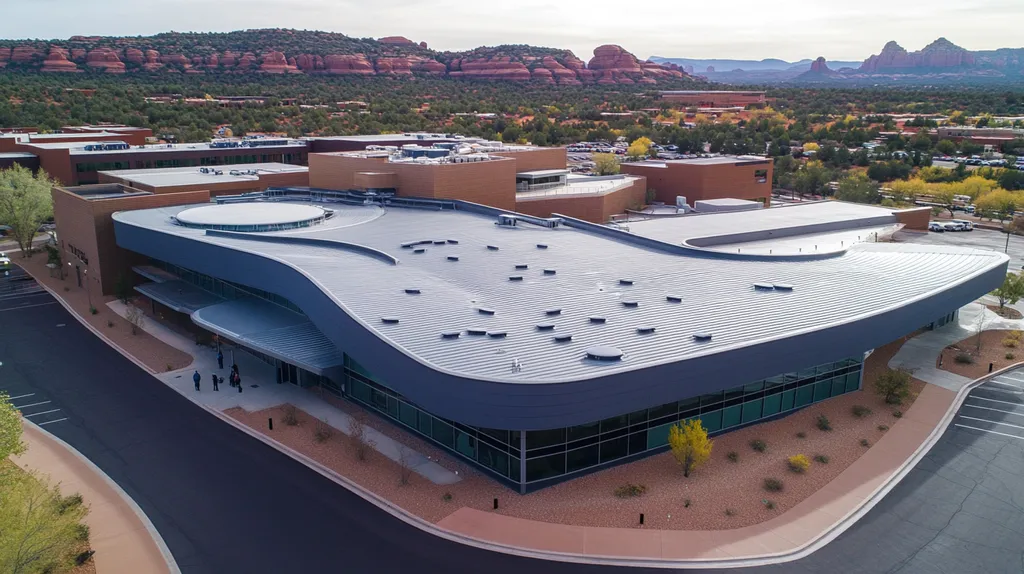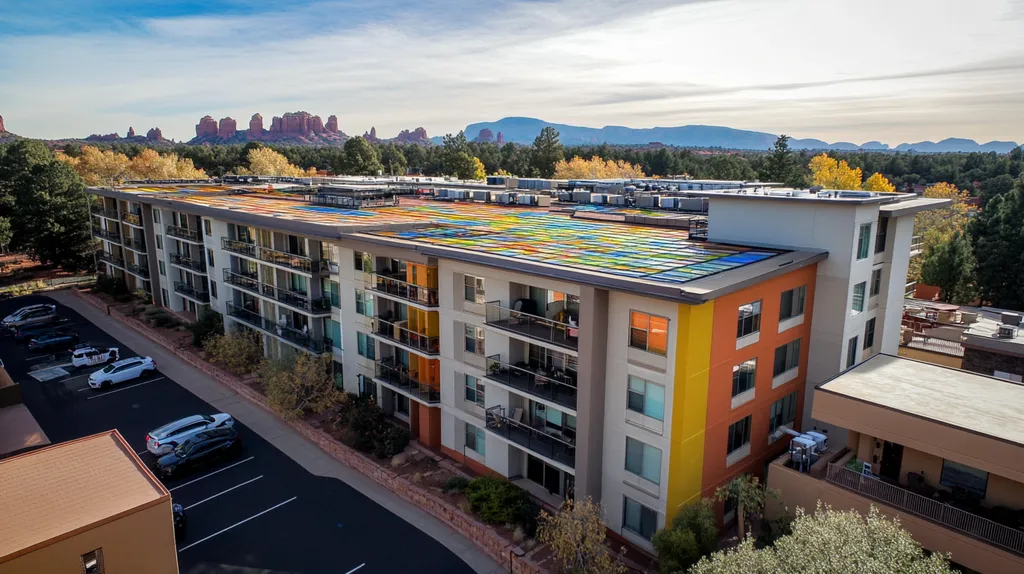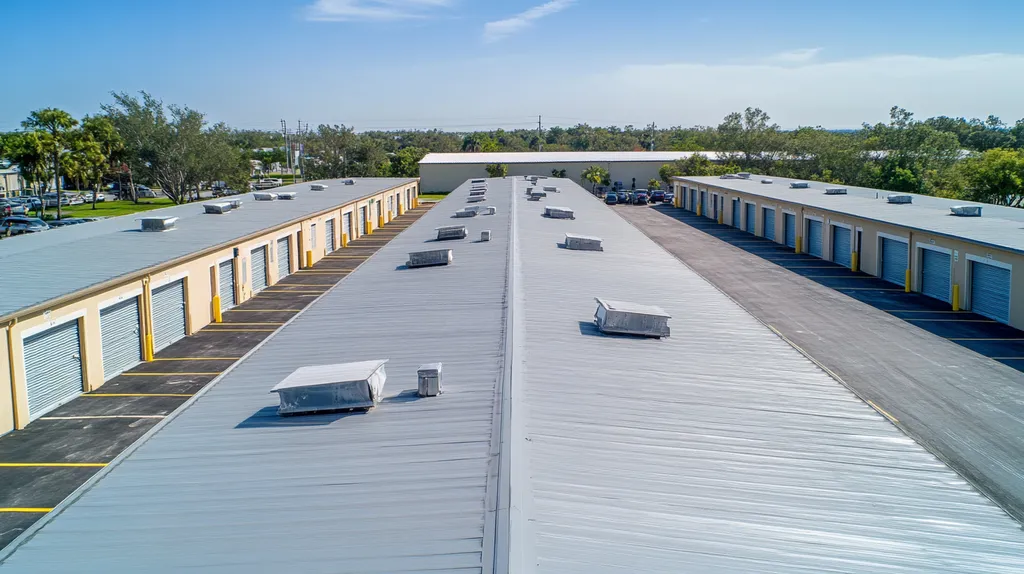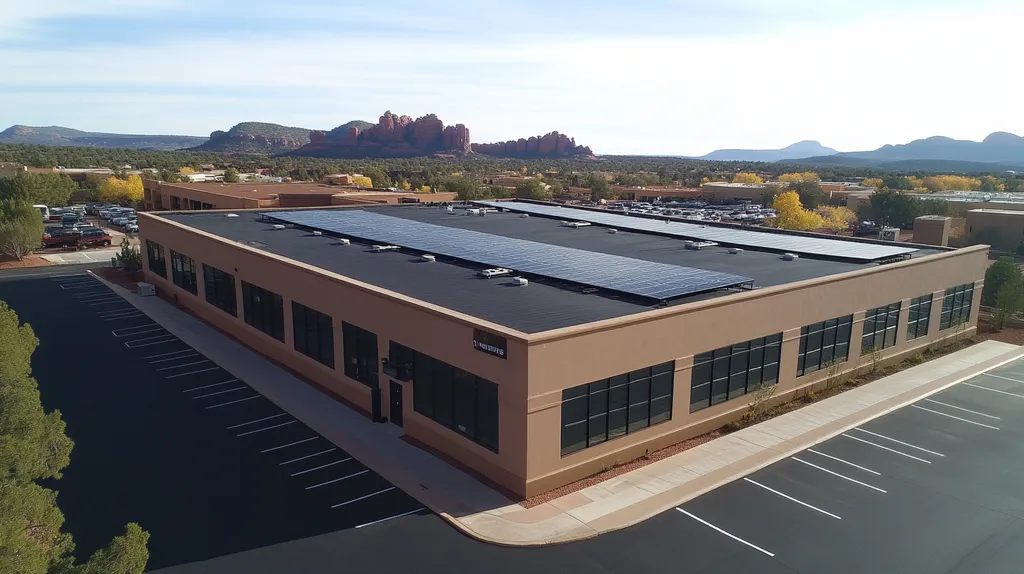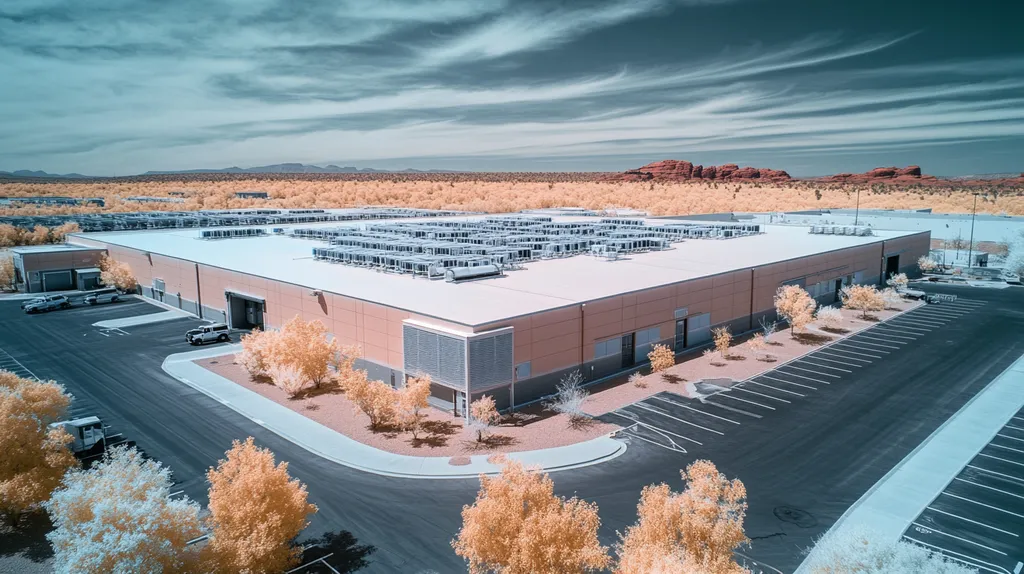Commercial property owners face mounting pressure to navigate an increasingly complex web of local roofing regulations, with violations resulting in fines exceeding $10,000 per incident. Recent industry data shows that 40% of commercial roof projects encounter costly delays due to regulatory non-compliance.
From material specifications to installation protocols, local regulations impact every phase of commercial roofing projects. Understanding and proactively addressing these requirements is crucial for protecting investments and ensuring project success.
This comprehensive guide examines performance factors, financial considerations, compliance requirements, risk management strategies, and operational procedures essential for navigating the regulatory landscape of commercial roofing projects.
SECTION 1: PERFORMANCE FACTORS
Understanding local regulations for commercial roofing is essential for property owners and facilities managers. Ignoring these regulations can lead to hefty fines and significant project delays. A study from the Environmental Protection Agency indicates that improper roofing installations can inflate energy costs by as much as 30%. Critical factors to consider include assessing local climate impacts, verifying material compliance, and ensuring durability standards are met.
Assessing Local Climate Impact on Roof Performance
The local climate is a key determinant in selecting the right roofing system for any commercial property. Extreme temperatures, heavy rains, or significant snowfall can greatly affect a roof’s durability and lifespan. Properties situated in regions prone to severe weather will require roofing solutions engineered to withstand these conditions.
For example, a flat roof in a snow-laden area needs materials that can handle extra weight. In contrast, regions that experience high UV exposure require roofs with reflective properties designed to reduce heat absorption. Property owners should analyze local climate data to guide their roofing decisions.
By factoring in local climate considerations, property owners can improve overall energy efficiency and enjoy long-term cost savings. Neglecting these assessments may lead to premature roof failures, incurring expensive repairs and replacements.
Collaborating with local experts on climate impacts will enable property owners to establish a roofing strategy that not only protects their investment but also complies with regulations.
Key Action Items
Evaluating Material Compliance with Regional Codes
Local building codes govern the materials permissible in commercial roofing projects, aiming to ensure safety, performance, and environmental sustainability. Some materials may be banned or regulated based on local health and safety standards.
For instance, areas with high fire risk often impose strict restrictions on flammable roofing materials. Similarly, regions emphasizing green initiatives might mandate the use of sustainably sourced products. Property owners must remain updated on these local requirements to guarantee compliance.
Neglecting to use compliant materials could expose property owners to increased liabilities and financial repercussions. Furthermore, projects might face delays as adjustments are made to bring them into compliance, ultimately impacting timelines.
Maintaining open communication with suppliers and local regulatory agencies is fundamental for ensuring material compliance. This proactive approach can save both time and money, providing peace of mind regarding regulatory fulfillment.
Key Action Items
Verifying Roofing System Durability Standards
Durability standards are crucial to ensure long-lasting performance of roofing systems. Local regulations typically prescribe minimum durability requirements tailored to environmental conditions and expected wear and tear. Property owners need to familiarize themselves with these standards to make informed roofing selections.
A roofing system situated in an area experiencing high wind speeds may necessitate reinforcements not required in calmer regions. Adhering to these durability standards can extend a roof’s lifespan and lower maintenance costs over time.
Many localities offer testing and certification resources to confirm that selected roofing systems meet durability expectations. Leveraging these resources can facilitate the installation process and help maintain compliance.
Failing to pay attention to durability standards may lead to premature roof failures, resulting in costly repairs and operational interruptions. Regular inspections and compliance with durability standards ensure a reliable roof performance that benefits property owners for years to come.
Key Action Items
SECTION 2: FINANCIAL CONSIDERATIONS
Understanding the financial implications of local regulations is crucial for the success of any commercial roofing project. Without adequate budgeting for permitting and inspection fees, property professionals risk facing unanticipated costs that can derail their timelines and inflate project budgets. It’s alarming to note that around 30% of projects end up exceeding their original budgets due to oversights in these areas. Recognizing the impact of local codes on material choices, while carefully planning for contingencies, is essential to ensure compliance and project success.
Budgeting for Regulatory Permitting and Inspection Fees
Securing the necessary permits and undergoing inspections is an essential part of commercial roofing projects, often entailing significant costs. Before starting any work, it’s vital to engage with local authorities to clarify the specific fees and expected timelines involved. Depending on the locality, some municipalities impose flat fees while others tie fees to project size or estimated value.
These permitting costs can add up rapidly, especially in urban areas where multiple inspections might be needed. Budgeting for these expenses from the outset is critical; failing to account for them can lead to delays as property managers await approvals, which ultimately disrupts project timelines.
A thorough understanding of these costs is essential for maintaining a project’s financial viability. By fostering transparent communication with local officials, property professionals can avoid unexpected expenses, thereby ensuring a smoother and more efficient permitting process.
Key Action Items
Cost Implications of Code-Mandated Roofing Materials
The types of roofing materials allowed under local building codes can have a significant impact on overall project costs. In many regions, there are expectations regarding material compliance, particularly concerning energy efficiency standards, which can command a higher initial investment. While these materials can save money over time, the upfront costs can pose a budget challenge.
Property professionals should take the time to thoroughly research local material requirements during the selection process. Partnering with suppliers who have intimate knowledge of local codes will enhance decision-making and potentially reveal cost-saving opportunities. Non-compliance can lead to fines and necessitate expensive redesigns or retrofits, exacerbating project costs.
Additionally, being aware of the lifetime cost implications of code-compliant materials enables better financial planning. Investing in quality materials may cut down future repair expenses, ultimately leading to financial relief in the years ahead.
Key Action Items
Planning for Contingencies in Regulatory Compliance
Every commercial roofing project should include contingencies for unexpected regulatory changes that may occur. Property professionals must have a plan ready to address potential alterations in local regulations that could impact their project. For instance, unanticipated code updates may necessitate redesigns or material changes, leading to unforeseen costs.
Setting aside a contingency budget—typically around 10-15% of the total project cost—can act as a financial safeguard. This proactive measure enables property managers to adapt to changes without jeopardizing their overall budget. Staying in constant communication with local authorities and industry organizations helps keep property managers informed of any upcoming regulatory shifts.
Ultimately, preparing for potential regulatory compliance issues not only mitigates risks but also fosters smoother project execution. A comprehensive plan allows property professionals to transform possible setbacks into manageable challenges, ensuring financial stability throughout the roofing project lifecycle.
Key Action Items
SECTION 3: COMPLIANCE REQUIREMENTS
Compliance remains a cornerstone of successful commercial roofing projects. Ignoring local building codes and zoning laws can lead to costly delays, expensive fines, and long-lasting impacts on a property’s value. In fact, research indicates that nearly 30% of roofing projects face compliance difficulties that disrupt schedules and inflate budgets. Understanding and adhering to these requirements is critical for safeguarding investments and ensuring smooth project execution.
Understanding Local Building Codes and Zoning Laws
Local building codes ensure the safety and structural integrity of commercial properties. These codes can vary significantly, setting rules on everything from acceptable roofing materials to load-bearing capacities. Property owners should connect with their local code enforcement offices to gain insight into specific regulations, preventing any unforeseen complications down the line.
Zoning laws also play a crucial role in what modifications are permissible on a property. For instance, a residential area might impose stricter limitations on roof height compared to a commercial zone, impacting design decisions. Familiarity with these restrictions can help property managers avoid costly redesigns or rework.
Addressing compliance from the outset significantly reduces the risk of project delays and remediation needs, which can extend timelines by weeks or even months. Therefore, property owners should incorporate research on local codes and zoning laws early in their project planning.
Key Action Items
Navigating Permit Application Processes and Timelines
The permit application process can be one of the most intricate stages of a roofing project. Each local jurisdiction may have distinct requirements, including detailed project plans and specifications. A common misstep is underestimating the time needed to secure the necessary permits, which can lead to disruptive delays.
For instance, some municipalities may take several weeks to review applications. A simple oversight like an incomplete application can trigger further delays. Therefore, a detailed, thorough application is essential for maintaining efficiency.
Moreover, anticipating necessary permits for specific roofing materials or design changes can streamline the process immensely. Engaging with local authorities early to clarify requirements minimizes potential roadblocks and enhances project momentum.
Key Action Items
Documentation and Record-Keeping for Inspection Readiness
Thorough documentation is vital for the success of commercial roofing projects, particularly when preparing for inspections. Keeping records of design plans, permits, and communications with local authorities helps ensure that all compliance needs are satisfactorily met. This paperwork acts as proof of adherence during inspections.
Implementing a centralized system for record-keeping allows property managers to easily access essential documents when inspectors arrive. For example, having meticulous logs of all alterations made can facilitate a smoother inspection process.
If discrepancies arise during an inspection, accurate documentation can expedite resolution. Organized records not only demonstrate a commitment to compliance but can also foster positive relationships with local authorities.
Key Action Items
SECTION 4: RISK MANAGEMENT
Understanding the risks associated with local regulations is critical for the success of any commercial roofing project. Non-compliance can result in hefty fines, project delays, and even legal action. It’s essential for property owners and facility managers to grasp the implications of OSHA standards and to remain vigilant about evolving regulations that could impact their roofing projects.
Identifying Liability Related to Non-Compliance With Regulations
Property owners are significantly liable if their roofs don’t meet local building codes. Non-compliance can lead to costly fines, work stoppages, and even lawsuits. For example, failing to adhere to insulation standards can result in penalties that run into thousands of dollars, putting project budgets at risk.
Additionally, non-compliance may increase insurance premiums or even lead to policy cancellations. Insurers focus closely on compliance history when determining risk and coverage, which can have long-lasting financial implications.
Conducting regular compliance audits is vital. Property managers should regularly verify that roofing materials and installation practices meet local regulations. This proactive approach can prevent severe penalties and ensure roofing work complies with established standards.
Consulting with legal experts in construction law helps navigate complex compliance requirements and mitigate liability risks, thereby protecting property investments.
Key Action Items
Managing Safety Standards Under OSHA and Local Rules
Adhering to OSHA safety standards is crucial for any roofing project. OSHA mandates safety protocols to protect workers from hazards, with falls accounting for a significant percentage of construction fatalities. Compliance is not just essential—it’s a legal obligation that ensures safe working environments.
Property owners must initiate safety training programs and ensure that all workers have access to personal protective equipment (PPE). Non-compliance can result in lawsuits and increased liability risk for property owners.
Local safety standards often complement OSHA regulations, making it vital to familiarize oneself with these requirements. For example, some municipalities impose stricter fall protection measures than OSHA does.
Regular safety audits are critical for ensuring compliance with both OSHA and local safety standards, allowing for the identification and mitigation of potential hazards before they result in accidents.
Key Action Items
Strategies for Handling Regulatory Changes During Projects
Regulatory changes can arise unexpectedly, impacting roofing project timelines and scopes. Property owners must remain adaptable and informed about any shifts in regulations to avoid non-compliance, which can lead to significant delays and added costs.
A robust communication strategy is essential. Maintaining open lines with contractors, legal advisors, and regulatory agencies keeps property managers updated on regulatory changes that could influence ongoing projects.
Establishing relationships with local regulatory bodies can provide advance insight into potential changes. This proactive engagement helps property managers plan accordingly and adjust project strategies in a timely manner.
Adopting a flexible project management approach enables rapid adaptation to regulatory changes, minimizing disruptions and ensuring compliance, ultimately preserving timelines and budget integrity.
Key Action Items
SECTION 5: OPERATIONAL PROCEDURES
In the fast-paced commercial roofing industry, following local regulations is not simply a choice—it’s a necessity for success. Alarmingly, 30% of roofing projects encounter delays due to regulatory hurdles, highlighting the need for a robust operational procedure. By mastering these procedures, property managers can ensure timely inspections, foster contractor compliance, and seamlessly integrate maintenance practices.
Establishing Workflow for Regulatory Inspections and Approvals
Building an effective workflow for regulatory inspections is crucial for maintaining project timelines. Property managers should begin by identifying all relevant local codes and regulations, which can be done through consultations with local authorities or detailed online research.
It is important to develop a clear schedule for inspections, aligning these with project milestones. For instance, if two inspections are required, scheduling them in advance allows for necessary preparations, reducing the risk of unexpected delays.
Additionally, documenting every interaction and outcome of inspections is vital. Keeping organized records not only helps track the project’s progress but also provides important references for future compliance needs.
Establishing open communication with local officials is essential. Regular check-ins can clarify expectations and resolve any potential concerns proactively.
Key Action Items
Coordinating Contractor Compliance and Reporting Duties
Coordinating contractor compliance with local regulations requires a well-structured approach. Property owners should clearly outline responsibilities in contractor agreements, specifying requirements for permits, safety protocols, and adherence to building codes.
Regular updates from contractors are vital for maintaining awareness of compliance statuses. Utilizing project management software can facilitate these updates, offering real-time visibility into compliance efforts.
Conducting periodic on-site inspections is essential for verifying that contractor work meets compliance standards. Early detection of issues can prevent costly corrections down the line.
Education plays a significant role in ensuring compliance. Providing training sessions or workshops can equip contractors with the necessary knowledge of local regulations and their importance.
Key Action Items
Integrating Regulatory Checks Into Maintenance Schedules
Compliance should not cease once a roofing project is complete; ongoing regulatory checks are key for maintaining compliance and preserving asset integrity. Regular inspections can identify potential violations before they escalate into larger problems.
During maintenance visits, it is wise for property managers to review any updates to local regulations since the last check. Staying informed about changes ensures that both installation practices and maintenance protocols remain compliant.
A checklist during maintenance evaluations helps ensure that all aspects of the roofing system are in order, covering everything from material integrity to safety practices. This forward-thinking strategy enhances overall roof longevity and contributes to effective asset management.
Key Action Items
SECTION 5: OPERATIONAL PROCEDURES
In the commercial roofing industry, adherence to local regulations is not just a guideline; it’s a necessity. A staggering 30% of roofing projects face delays due to regulatory issues, highlighting the importance of a solid operational approach. Understanding and navigating these procedures is crucial for the success of a roofing project and for protecting investments. This section outlines essential operational practices to streamline inspections, ensure contractor compliance, and integrate ongoing maintenance.
Establishing Workflow for Regulatory Inspections and Approvals
Creating a robust workflow for regulatory inspections is vital for meeting project deadlines. Property managers should begin by identifying all relevant local building codes and regulations. Consulting with local authorities or using online resources can provide needed guidance.
Next, establish a timeline for inspections that aligns with project milestones. For example, scheduling inspections in advance helps ensure adequate preparation, reducing the risk of unexpected delays.
Meticulous documentation of every inspection interaction and outcome is crucial. This practice helps maintain project organization and provides clear references for future compliance needs.
Regular communication with local officials is essential. Engaging with them through consistent check-ins allows for the clarification of expectations and proactive resolution of any minor concerns.
Key Action Items
Coordinating Contractor Compliance and Reporting Duties
Ensuring contractor compliance with local regulations requires a structured approach. Property owners must clearly outline specific responsibilities in the contractor agreement, which should cover permits, safety measures, and adherence to building codes.
Regular compliance updates from contractors are essential to keep property owners informed of project status. Implementing project management software can enhance visibility into compliance efforts, providing real-time access to relevant information.
Periodic on-site inspections are crucial for confirming that work meets compliance standards. Identifying issues early on helps avoid costly corrections later.
Education plays a significant role in ensuring compliance. Hosting training sessions equips contractors with the knowledge necessary to understand local regulations and their importance.
Key Action Items
Integrating Regulatory Checks Into Maintenance Schedules
Regulatory compliance shouldn’t stop once the roofing project is done. Incorporating regulatory checks into ongoing maintenance schedules is key to ensuring long-term compliance and asset longevity. Regular inspections can uncover potential violations before they escalate into significant issues.
During maintenance visits, property managers should review local regulations for any updates since the last check. Staying informed about changes ensures that both installation practices and maintenance protocols align with current standards.
Establishing a checklist for compliance during maintenance evaluations ensures every aspect of the roofing system is reviewed, from material integrity to safety practices. This proactive strategy safeguards investments and helps maintain structural integrity.
Integrating regulatory checks into maintenance not only assists with compliance but also enhances the roof’s longevity, making it a vital aspect of asset management.
Key Action Items
Moving Forward
With commercial roofing violations resulting in fines exceeding $10,000 per incident and 40% of projects facing costly regulatory delays, property professionals can no longer afford to treat compliance as optional.
The evolving landscape of local regulations demands a proactive approach, combining thorough planning with systematic execution across performance, financial, and operational domains.
Success hinges on establishing clear workflows for inspections, maintaining detailed documentation, and implementing regular compliance audits throughout the project lifecycle.
By adopting the strategies outlined in this guide, property professionals can transform regulatory challenges into opportunities for enhanced building performance, improved safety standards, and optimized long-term value.
The future of commercial roofing belongs to those who embrace regulatory compliance as a cornerstone of project excellence.
FREQUENTLY ASKED QUESTIONS
Q. How do local climate impacts affect commercial roof performance?
A. Local climate significantly influences roofing system choices, dictating material selection and durability requirements. Extreme weather, such as heavy rainfall or high UV exposure, necessitates specific roofing materials to enhance longevity and efficiency. Failing to account for these factors can result in premature roof failure, costly repairs, and regrets down the line.
Q. What budget considerations are there for commercial roof compliance?
A. Budgeting for necessary permitting and inspection fees is crucial when planning roofing projects. These costs can exceed initial estimates if not adequately anticipated, leading to project delays and financial strain. Engaging local authorities early to clarify these expenses helps avoid unforeseen budget overruns.
Q. Why are local building codes important for commercial roofs?
A. Local building codes ensure roofs are safe, structurally sound, and compliant with regulatory standards. Understanding these rules helps prevent expensive fines, project delays, and potential hazards. Addressing compliance issues early can streamline project execution and safeguard your investment.
Q. How to assess risks of non-compliance in commercial roofing?
A. Non-compliance with roofing regulations can result in hefty fines, project halts, and increased legal liability. Conducting routine compliance audits helps identify gaps and maintain adherence to local codes. Engaging legal professionals for guidance is also wise to navigate complex requirements and mitigate risks effectively.
Q. What are effective strategies for coordinating contractor compliance?
A. Clearly defined responsibilities in contractor agreements are vital for ensuring compliance with local regulations. Regular updates and on-site inspections help verify adherence to safety protocols and building codes. Providing training sessions can also empower contractors with knowledge about the significance of compliance.
Q. How can I ensure ongoing compliance after a roofing project?
A. Conducting regular inspections that align with maintenance schedules is key to ensuring long-term compliance. Reviewing local regulations at each visit helps identify any updates that may affect your roof’s integrity. This proactive approach fosters awareness and maintains adherence to all applicable standards.
Q. What are common misconceptions about commercial roofing regulations?
A. A common misconception is that compliance is only necessary during installation. In reality, ongoing adherence to local regulations is critical for maintaining safety and effectiveness long after completion. Ignoring updates may lead to compliance pitfalls, escalating repair costs, and potential safety hazards down the road.

